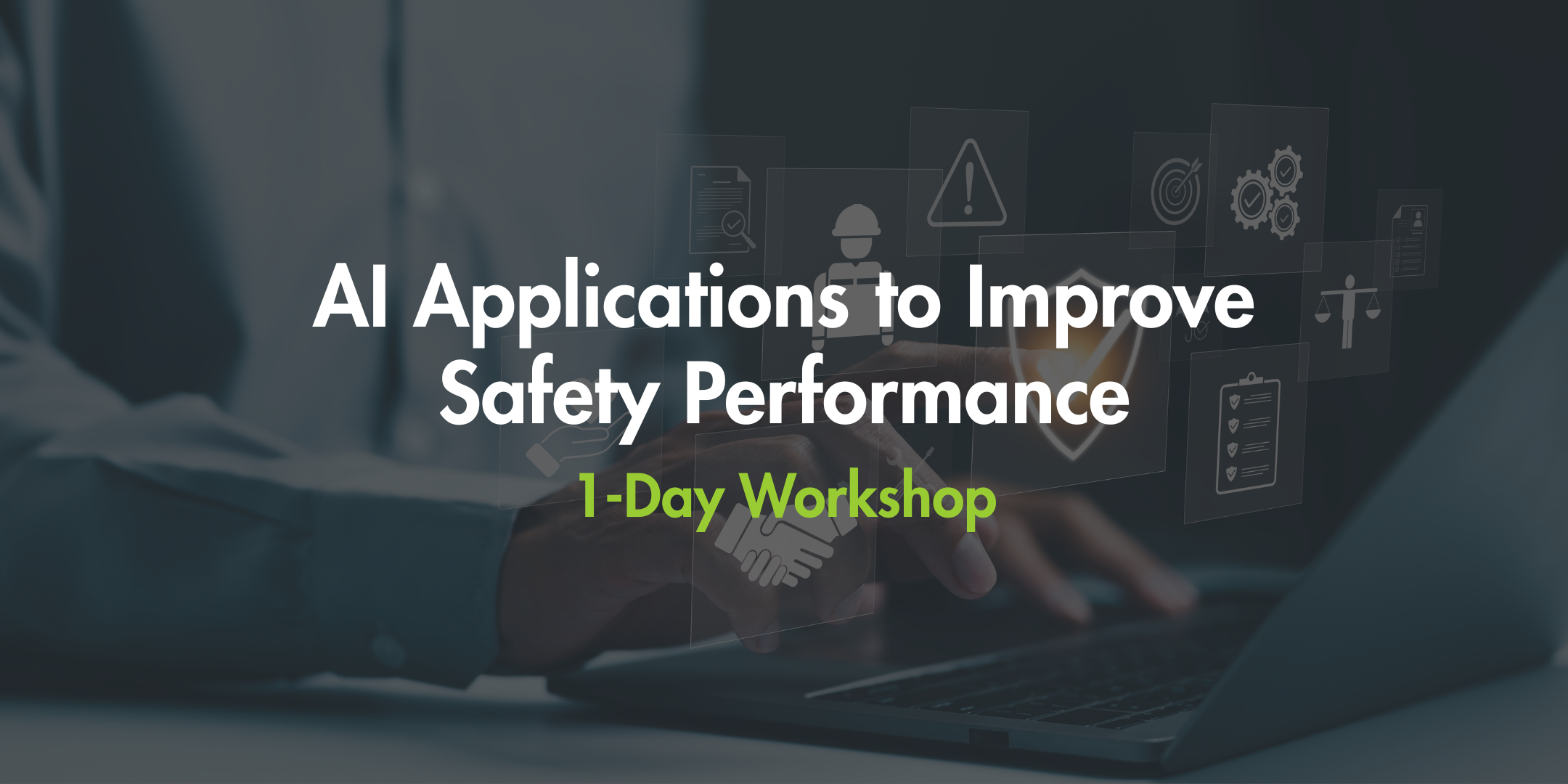
Date: June 16, 2025
Time: 8:30 AM – 4:30 PM
Location: Hotel Blackfoot – 5940 Blackfoot Trail SE, Calgary, AB T2H 2B5
Ticket: $175 per person
Artificial Intelligence has evolved from early concepts like Charles Babbage’s Analytical Engine to powerful modern tools like IBM’s Deep Blue and OpenAI’s GPT-3. Today, AI plays a transformative role in many fields—including workplace safety. Applications include predictive analytics for risk prevention, AI-based simulation training, computer vision for hazard detection, and voice analysis to assess worker fatigue. With rapid advancements and growing adoption, AI continues to enhance safety management systems.
In this 1-day workshop, we focus on how AI is transforming safety performance across industries. Targeting safety professionals that are new to AI and wishing to explore all the possibilities that it offers, the workshop offers the following:
- Real-world examples of AI in safety monitoring and incident prevention
- Hands-on demonstrations of emerging AI tools
- Interactive discussions with experts and peers
- Practical strategies for implementing AI safely and effectively
We look forward to exploring the future of safety with you!
Session Information
Welcome and Introductions
Glyn Jones, EHS Consulting, Part of Bravo Target Safety
8:30 AM – 8:45 AM
AI has many applications in improving workplace safety including improved predictive analytics for risk prevention, AI-based training involving simulation, enhanced safety protocols including the use of computer vision and natural language processing to assess workplace hazards, and the use of AI analysis of vocal patterns to assess fatigue and employee burnout. The applications are increasing daily and the rate of change in AI applications is best described as highly dynamic and accelerating due to continuous advancements in research, increased computational resources, data availability, and cross-industry adoption. In this session we will review the application of AI to workplace safety and improved safety management systems.
About the Speaker: Glyn Jones is a health and safety expert with 30+ years in industrial hygiene and safety consulting. He holds advanced certifications and has taught at Canadian universities. Glyn focuses on integrating AI and technology to improve workplace safety.
AI-enhanced Natural Language Processing and Video Analysis as a Tool to Improve FLHAs
FYLD
8:45 AM – 9:15 AM
Workplace inspections and hazard assessments are essential for identifying and preventing risks before they cause harm. Tools such as FYLD are a good example. Enhanced with AI, natural language processing, and computer vision, FYLD-generated hazard assessments improve accuracy, efficiency, and real-time decision-making. This advanced system creates detailed hazard logs based on observed conditions, spoken input, and known risks—leading to smarter, faster safety decisions that also support productivity and sustainability.
About the Speaker: FYLD is an AI-driven platform that helps infrastructure leaders improve operations, safety, and sustainability with real-time data insights. Founded in 2020, it is recognized for advancing productivity and quality in the industry.
From Risk to Resilience: How AI is Transforming Fatigue Management
Dr. Prentice Tom, Tenvos AI
9:15 AM – 10:15 AM
Identifying and managing fatigue in real time remains a challenge in industrial safety. Tenvos AI offers a proactive voice-based impairment management solution for hazardous fatigue and substance use in real time. This session presents a case study from its deployment at a petrochemical facility.
About the Speaker: Dr. Prentice Tom is an experienced health industry executive, with skills in healthcare and physician management, provider relations, and health technology adoption programs. He is one of the founders of Tenvos AI, a tool that tests for functional impairment in real-time, evaluating neuromotor effects like voice, movement and behaviour.
PART 1 – Lead with Questions: HSE Thought Leadership in the Age of AI
Marc Smith, Integrated Sustainability Consultants
10:30 AM – 11:15 PM
As AI continues to evolve, HSE professionals must lead with clarity, not fear. This session explores how to stay the Thought Leader while using AI as a trusted thinking partner. You’ll learn how to shift your mindset from efficiency to intentionality, and why AI is best used to amplify—not replace—human judgment. We’ll break down where your leadership is irreplaceable and where AI can carry the load. Join us to explore real-world applications, ethical framing, and the future of human-machine collaboration in HSE.
About the Speaker: Marc Smith is an HSE leader with 15+ years of experience driving safety systems and innovation across North America and the Caribbean. He specializes in integrating AI and digital tools to proactively reduce risk and improve safety culture.
PART 2 – Prompting with Purpose: A Practical Guide to Leading with AI in HSE
Marc Smith, Integrated Sustainability Consultants
11:15 AM – 12:15 PM
Prompting is a leadership skill — not just a tech trick. In this hands-on session, you’ll learn how to craft prompts that connect your HSE judgment with AI’s speed and structure. We’ll explore three levels of prompting: basic, expert, and interview-style. You’ll apply them to real tasks like policy writing, root cause analysis, and procedure simplification. More than automation, this is about using AI to amplify your thinking. You’ll leave with prompt ideas, practical strategies, and a clearer sense of how to lead through collaboration — not delegation. Come curious, leave empowered.
About the Speaker: Marc Smith is an HSE leader with 15+ years of experience driving safety systems and innovation across North America and the Caribbean. He specializes in integrating AI and digital tools to proactively reduce risk and improve safety culture.
Safety Scan – The Evolution of Impairment Detection Technology and AI
Randal Roberts, SafetyScan Technologies
12:45 PM – 1:30 PM
Industry continues to use technologies first developed in the 1970s to detect workplace danger from alcohol and drugs. Lots of challenges exist – cannabis is legal and privacy is top of mind for most people. The metabolites of cannabis stay in the body for weeks resulting in positive (non-negative) drug tests due to past use in personal time. A failed drug test does not mean the subject is impaired. New Impairment Detection Technology (IDT) determines real-time impairment and pairing daily workforce data from these devices with AI/ML gives companies leading indicators and actionable predictive analytics.
About the Speaker: Randal Roberts has over 30 years of international experience in sales, marketing, and development of medical devices. Specializing in commercializing new technologies, he has proven expertise across sales, marketing, product development, finance, operations, technical support, and customer service.
Advice from a CIO – Developing Effective AI Use Policies for the Workplace
Michael Kulpa, SIRKit
1:30 PM – 2:15 PM
More than 70% of employees are already using AI tools in their daily work—often without formal guidance. Yet, many organizations still lack a clear policy to govern how these tools should be used. An effective AI use policy should balance the practical needs of employees with the organization’s requirements for security, privacy, values, and culture. It should also provide clear, actionable guidance on which tools and practices are acceptable.
In this session, you’ll learn how to create a practical and responsible AI use policy. We’ll cover key considerations, common pitfalls, and a set of “Dos and Don’ts.” You’ll leave with tools and resources to help you draft or improve your own policy right away.
About the Speaker: Michael Kulpa is a systems administrator experienced with Windows Server and legacy systems. He stays current through ongoing training and podcasts. Since 2009, he has volunteered with the Edmonton New Technology Society and creates technical training for productivity apps.
Real World AI: Field-ready Safety Applications that Actually Stick
Elden Stewart
2:30 PM – 3:15 PM
Discover how AI tools like ChatGPT are being applied in real-time to improve safety meeting quality, hazard assessment efficiency, and frontline engagement. This session walks through tangible, field-tested examples, and strategies that safety leaders can implement immediately.
About the Speaker: Elden Stewart is a safety professional with 25 years of experience leading health, safety, and ESG efforts in Canada’s energy and resource sectors. A CRSP and certified auditor, he combines practical field knowledge with technology and data to simplify safety strategies, improve engagement, and drive meaningful results beyond compliance.
From Reactive to Predictive: How AI is Reshaping Safety Management Systems (SafeSphere)
Amir Abrari, SafetyLog Inc.
3:15 PM – 4:00 PM
This session explores how artificial intelligence is being integrated into modern safety systems to enhance reporting, predict incidents, and identify risk trends. Using SafeSphere’s development journey as a case study, we’ll highlight practical AI applications in hazard reporting, analytics, and behavior recognition.
About the Speaker: Amir Abrari is the founder of SafetyLog Co. and creator of SafetySphere, an AI-powered QHSE platform that modernizes workplace safety. With over 28 years in Health, Safety, and Environmental management, mainly in oil & gas, he helps companies move beyond outdated systems to smarter, data-driven solutions focused on real impact.
Mini Tradeshow
There will be a tradeshow space where attendees can interact with different AI safety programs. More information will be provided at a later date. If you have any questions, please contact Glyn Jones at gjones@ehsp.ca.








